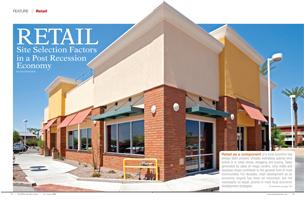
 Retail as a component of a local economy has always been present. Virtually everybody spends time online or in retail stores, shopping and buying. Taxes generated by sales at mega centers, strip malls and boutique shops contribute to the general fund of most communities. For decades, retail development as an economic engine has been an important, but not necessarily co-equal, priority in most local economic development strategies.
Retail as a component of a local economy has always been present. Virtually everybody spends time online or in retail stores, shopping and buying. Taxes generated by sales at mega centers, strip malls and boutique shops contribute to the general fund of most communities. For decades, retail development as an economic engine has been an important, but not necessarily co-equal, priority in most local economic development strategies.
However, as the nation emerges from a three-year recession and municipalities more clearly understand the importance of sales tax-generated revenues, site selection for new retail development becomes even more critical.
The Importance of Retail Development to the Local Economy
Retail developers of all sizes need to be mindful of the role retail operations play in local economies. Despite a wide variation in taxing and municipal financing structures, the vast majority of U.S. cities rely on sales tax as a primary revenue component of their budgets. An example would be Oklahoma City: sales tax creates 50 percent of the funding for its operating budget; 60 percent of those funds accrue directly from retail sales.
Reliance on revenues generated by retail sales extends over the entire spectrum of municipalities. In a survey conducted by the National League of Cities, October 2010, nine out of ten cities had trouble in their ability to meet their fiscal needs. This was a direct result of declining property tax income and restrained consumer spending. Municipal cutbacks have gone beyond imposing furloughs and shutting down non-essential services. They now extend into reducing public safety, police and fire staffing.
Retail development and storefronts are also a critical component of a community’s capacity to generate jobs. On the national level, according to the U.S. Bureau of Labor Statistics, retail trade is the largest, non-farm employment sector in the country. When observed from a 25-year perspective, the average regional mall generates over 54,000 jobs. A typical lifestyle center produces just fewer than 24,000 jobs. The Weitzman Group reports that a 200,000-square-foot community shopping center employs somewhere between 400-500 workers.
While on-site retail employment is the direct impact, the indirect and induced impact of retail-generated employment strengthens the case for placing retail development in a community’s strategic economic plan. To drive employment and increase revenue generated by sales tax a new development and recruitment model will be required. Municipalities will be developing strategies and performance models that aggressively court retail operations.
The Emerging Short Term Retail Picture: 2011-12
As with most commercial segments of the U.S. economy, the recession changed the retail community. Chuck Stevens, director of marketing for R.A. Smith National Inc., sums up the economic environment for retail development projects: “The retail market has some positive momentum, but will take years before recovery is complete. A strong retail comeback aligns within markets that have solid employment. However, the slow housing recovery is also slowing retail’s recovery. While demand for retail space is trending up, absorbing [these] dark boxes is a challenge, due to a lack of tenants willing to reinvigorate the vacant book, electronic, music and video stores.”
Drilling down on the topic areas, here is what we see:
Technology and the Internet
Access to and utilization of technology is giving the mobile shopper an ability to compare prices or buy online. Seen as a threat by many retailers, others are adapting their marketing, pricing and online presence to generate sales. The significant increase in business coming from consumers with iPads and other mobile devices supports this trend.
Major retailers, including luxury brands, are beefing up their tech to stay competitive and fight off new contenders. Neiman Marcus reported that internet sales were the fastest growing segment of their business, with a 15.6 percent increase over last year.
This movement is not confined to high-end retailers. From larger corporations like The Gap, to many small retail operations, decision-makers are channeling energy and resources into mobile-optimized sites. These sites let the customer see the latest products and collections, find a store location and buy products without ever being in the brick and mortar property.
Retail Store Expansions
Looking ahead, 2012 is shaping up to be a good year for retail expansions. According to ICSC’s Robert Carr, about 20 retailers detailed new store strategies at the just-concluded ICSC RECon Retailer Runway. Not one retailer said it plans less store growth in 2012 than it projected in 2011. These projections for growth came from both large and small retailers.
While retailers noted that plans for expanding the number of stores were moving forward, they anticipated new store footprints to be smaller and to only be located in either rural or densely urban environments.
Shopping Centers, Malls and Outlet Centers
Enclosed malls may not be as flexible as online or virtual stores, yet they are making a slow comeback. Vacancy in major malls is averaging 9.1 percent versus 10.9 percent at small strip centers (Reis, Inc.); discount retailers and outlet malls have shown the most interest in doing deals.
Retail construction trends indicate developers are designing new mall construction around the concept of an open-air entertainment center. In these properties, people spend more time than in enclosed structures. Rick Caruso, president, and CEO of Caruso Affiliated, reports people spend about 180 minutes at his property. This is about twice the time of a typical mall visit.
Financing and Access to Capital
While no one is handing out free samples, capital is becoming available for new projects. R.A. Smith’s Stevens: “In major markets, funding has improved. Outside of major markets, smaller cities and tertiary markets have not seen much relief in the availability of capital. However, that is changing. The appetite is growing for return potential greater than low-yielding Treasuries. Foreign investment in real estate, which has been fixated on coastal markets, is now starting to shift toward secondary and tertiary markets.”
Evaluating a Community’s Readiness for New Retail Development
Given the need to generate or recapture income produced by taxable retail sales, forward thinking communities will be approaching the  retail development market more aggressively. When considering a community, consider these four characteristics:
retail development market more aggressively. When considering a community, consider these four characteristics:
Retention
How a community works with its existing, established, long-term companies is a key indicator of how it works with business in general. The tools for staying in touch are available to virtually all jurisdictions, yet how they use them is the real qualifying key. For example: Does the economic development agency consider retail a priority? Is there periodic contact via survey, retention calls, etc.? Are there gatherings where business owners and elected officials can have open dialogue? This is a vehicle that can significantly bridge the communication gap between the decision makers and those who will be most impacted by their ruling.
Revitalization
How has the municipality made improvements to infrastructure or the streetscape? Have they modified zoning to include mixed-use occupancy, high speed internet and façade repair? Communities that maintain and upgrade civic infrastructure are priority targets for expansion plans.
Replacement
How does the city work with a business that needs to move because it does not fit for an overall retail development plan? Although business replacement is a less popular tool, it needs to be applied when an existing use does not fit into the overall plan for retail revitalization. The process used by a municipality is a clear indicator as to their sensitivity toward business.
Recruitment
Cities that want retail development are in the marketplace now. A survey of 350 communities, conducted by Geneva Analytics Ltd., found that 75 percent do not actively market to retail outlets, only 50 percent market to commercial real estate brokers or site selectors, and 42 percent to retail developers.
Finding Communities That are Ready
The marketplace is not a static environment. Local governments need to move aggressively within it to capture an expanded revenue base. Organized municipalities will first create an internal environment that focuses on the mission while not compromising the public good. Prior to letters of intent, here are some additional areas for review before signing on the dotted line:
Up-To-Date Codes and Processes
Land use regulations are the building blocks under which all development takes place. Forward thinking cities keep their development codes and zoning maps up to date. Likewise, such communities have trained and empowered decisions makers at the front counter to speed up the processing of plans and permits. Cities that actively seek quality development have clear, reliable processes and timetables.
Know and Understand Your Market
Access to recent, reliable data is critical. Many retail companies perform their own research, however, the local input brings perspective to the project. Communities should have a recent inventory of companies, what they do and where they are. Demographics and psychographics are baseline elements of a knowledgeable community. A recent retail GAP analysis for evaluating which operations are missing from the community’s business mix is also a great asset.
Development Policies
Direct, coherent policies set the tone and parameters of the process. Local development policies should clearly define the process, estimate timeline and outline how incentives will be allocated, etc.
Venturing Forward
In the post recession economy, it is evident that retail has emerged as a valuable strategic tool for generating revenue and jobs for many local economies. There are trends on the horizon that can significantly drive how and where retail development takes place. One of these trends is consolidation of governments in second and third tier markets.
A leading community in the move toward a regional government is Louisville, Kentucky. Ten years ago, Louisville merged with the county to form a new, metropolitan-based government. Since the 2003 merger with surrounding Jefferson County, Louisville has become the nation’s poster child for consolidated government. On the surface, the merger of governments might not appear to be an influence. However, since the merger, Louisville has attracted four corporations, generated over 1,000 new jobs and has become a center for the aging health care industry. In October 2010, the $238 million “KFC Yum! Center” opened in downtown.
Is Louisville alone in this governance philosophy?
No. There are indicators that major population and second tier market centers are considering fundamental changes to their governing structures. One such population center is Dayton/Montgomery County in Ohio, where County Commissioner Dan Foley is pressing the issue forward. Foley believes that a consolidated government would serve as a strong attraction for alluring core industry groups, including retail. “In my opinion, moving toward a metropolitan local government structure could go a long way towards improving our regional economic climate and our ability to compete nationally and globally. This will take much work, but a more innovative local government structure could help transform the Dayton region for years to come.”
Regionalism, as a concept, develops governing structures that are more competitive and innovative. These, in turn, create an environment that is appealing to companies and the creation of jobs. Smaller and mid-sized retail development must maintain an awareness of the trend.
The Bottom Line
In this new round of competition, commitment and mobility are paramount. Communities that are ready to compete now, particularly those that are smaller, can quickly position themselves to capture the best of the expanding retailers. Size is less relevant in the emerging retail economy. Growth is taking place, following the path of innovation and flexibility. Those companies and developers that can identify and adapt to new market realities are best positioned to increase market share and profitability.

